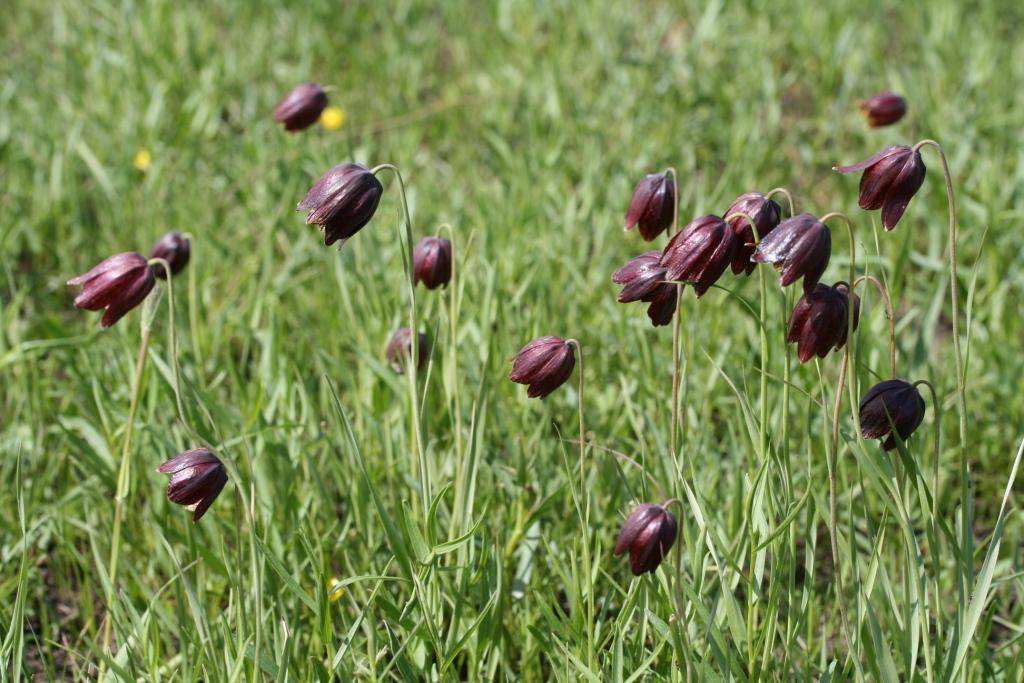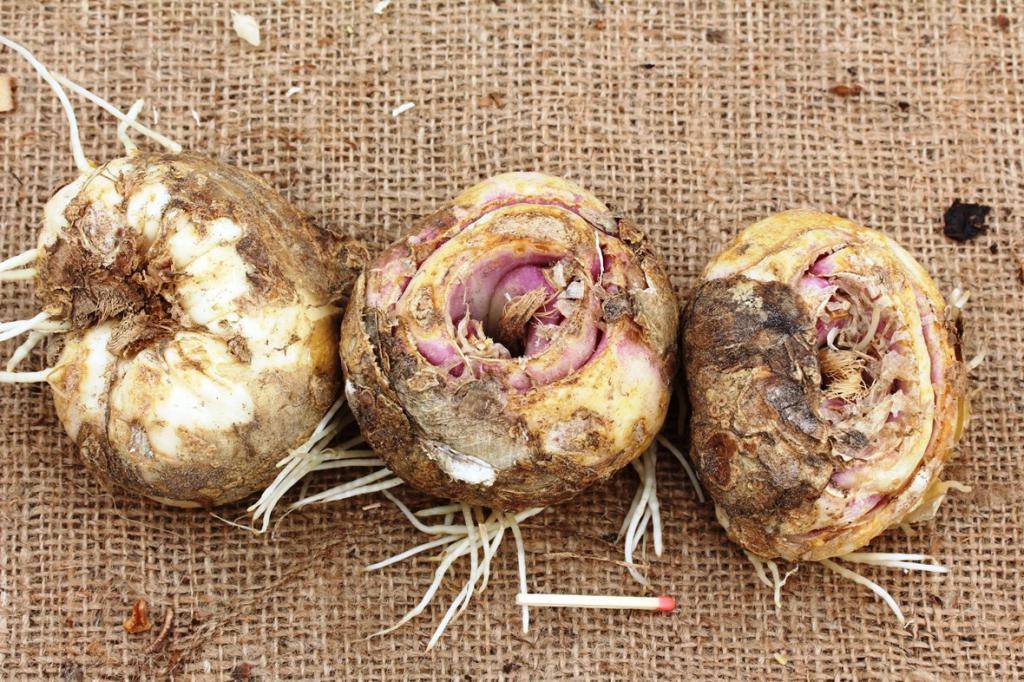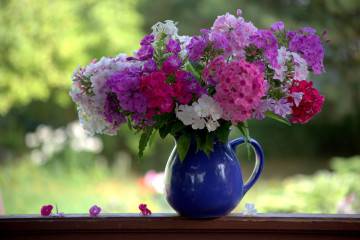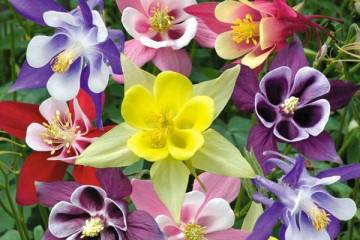Russian hazel grouse: what a flower looks like
Content:
The Russian hazel grouse, listed in the Red Book, is a beautiful perennial that served as the ancestor of modern cultivated varieties. It is a great success to meet him in the wild!
What does Russian hazel grouse look like?
The plant is a bulbous plant, it grows up to 50 cm in height. On a long peduncle, a flower drooping like a bell can be only one or collected in a loose brush from 2 to 5 pcs. It blooms in April and blooms until May.
The corolla of the hazel grouse is not very large (up to 3.5 cm in length), but due to the rich brown-violet color it is very clearly visible against the background of the greenery of the meadow. The leaves at the bottom hug the stem, have a lanceolate shape, they are up to 9 cm long, up to 5 mm wide.
The petals can be more or less colored with dots in a checkerboard pattern. The shape of the corolla is a bit like a glass, which gave the hazel grouse the generic name Fritillaria (from the Latin Fritillus - “a glass for dice”). There is no pleasant aroma.
Botanical description
Russian hazel grouse (Fritillaria Ruthenica) is a member of the Liliaceae family. Distributed in the European part of Russia, the Caucasus and Western Siberia. The underground part is a bulb from which leaves and peduncles grow in spring. After the seeds ripen in July and shedding them, the aerial part completely withers, and the bulb goes into a dormant state until the next April. This lifestyle allows the hazel grouse to be classified as an ephemeroid.
Distribution and ecology
Grouse prefers to grow in meadows and edges of deciduous forests, along roads, not far from natural reservoirs. Distributed along the Dnieper, Volga, Don. It can still be found in nature reserves and the forest-steppe zone of Western Siberia, in Central Asia, in the Caucasus.
Status and rarity category
The hazel grouse has been included in the Red Book of the RSFSR since 1988. At present, it is included in the Red Book of the Russian Federation, Belgorod Region and Ukraine. Wherever it grows in the wild, it is protected. Rarity class - V, which means the vulnerability of the species throughout the protected area.
Necessary security measures
Wherever you can still find Russian hazel grouse in the wild, you cannot pick its flowers and dig up the bulbs. Every destroyed plant jeopardizes the survival rate of the species. If a child comes across a beautiful flower during a walk, it should be explained why it should not be picked.
Seed propagation
In June, all formed and slightly dried seed pods are broken off. Dry them well. The seeds will be ready for sowing by the end of August. A sowing bed is chosen in a bright place.The planting depth is 1 cm. From above, the crops are mulched with peat.
Normally, seedlings will appear only next spring in April. Germination rate is from 50 to 80%. The surviving bulbs will become adults only in the 4th year after sowing the seeds.
Reproduction by dividing the bulbs
The onion can be cut in half. The cut is powdered with crushed activated carbon, allowed to dry well. After 3 weeks, it can be planted in a permanent place. The maximum planting depth is up to three times the height of each section.
Planting bulbs
During the season, the uterine bulb grows from 1 to 3 babies. You can dig it out when the roots are dry. Usually, the signal for this is the final ripening of the seeds and the complete drying of the aerial part.
Daughter bulbs, which take about 3 years to reach maturity, are planted so that they receive more nutrition and do not interfere with each other. Immediately after digging, they must be washed in a solution of potassium permanganate for disinfection, and then laid out in 1 layer in a warm and well-ventilated dark place to dry.
Storage of planting material
The optimum storage temperature is 30-35 ° C. This is what keeps in the regions of natural growth of hazel grouse in summer. Therefore, the bulbs are laid out under awnings in the fresh air, the main thing is that the sun does not fall on them. If they are removed to the basement, then they must be sprinkled with peat chips or dry sawdust.
Landing technology
The landing site is chosen based on the following conditions:
- not flooded by spring floods;
- light;
- well fertilized.
The optimal time for disembarkation is September (first half).
Soil preparation
The soil is suitable fertile with a neutral or alkaline reaction. Sour and heavy soil types are not suitable. When digging, it is recommended to add crushed charcoal, which will dry the soil, as well as to fertilize it. Additionally, the soil is mixed with sand, which will not allow moisture to accumulate.
Each onion is inspected. If traces of mechanical damage are visible, it is necessary to disinfect the cut and sprinkle it with activated charcoal. Planting is carried out at three heights of the bulb itself.
Growing difficulties
The main feature of the hazel grouse is that it does not tolerate waterlogging, because of which the bulbs can simply rot in the ground. Due to excess moisture, there may be no flowering in the spring. If the flower grows small and inconspicuous, this indicates problems with the roots, for example, a lack of nutrition.
Care
Usually the Russian hazel grouse has enough natural precipitation to increase the volume of the bulbs. However, in dry summers, it is worth additionally watering twice a month. The faded and wilted aerial part is cut off at ground level as soon as it dries.
When sprouting seedlings in spring, nitrogen fertilization is applied, and during the distillation of peduncles, they are additionally fed with superphosphate and sulfate at the rate of 1 tbsp. a spoonful of dry fertilizer is scattered over 1 m² of plantings.
Diseases and pests
In waterlogged soil, hazel grouses are threatened by rot. If the rotten area of the dug out bulb is small, then it is scraped out with a sharp knife and treated with a fungicide.
Rusty spots on the top of the leaves are a fungal disease called rust. The affected parts of the plant must be cut off and burned. The planting is sprayed with a fungicide. For prophylaxis, hazel grouses are planted after digging in a new place.
Use in landscape design
The flowers of Russian hazel grouse on thin long peduncles are a beautiful sight.They look especially beautiful in the company of other varieties of hazel grouse: white, chess, royal, Persian, Kamchatka. When choosing neighbors, it is important to consider the bulbs' intolerance to the bay. Do not plant tulips and daylilies nearby. A good place is the elevated part of the flower bed, where, after the hazel grouse, letniki with a shallow root system and undemanding to watering will bloom: saxifrage, sedum, stonecrops, undersized gypsophila, purslane.
There are no difficulties in growing Russian hazel grouse. This is a planted and forgotten flower. Every spring it blooms one of the first and only becomes more beautiful.



















